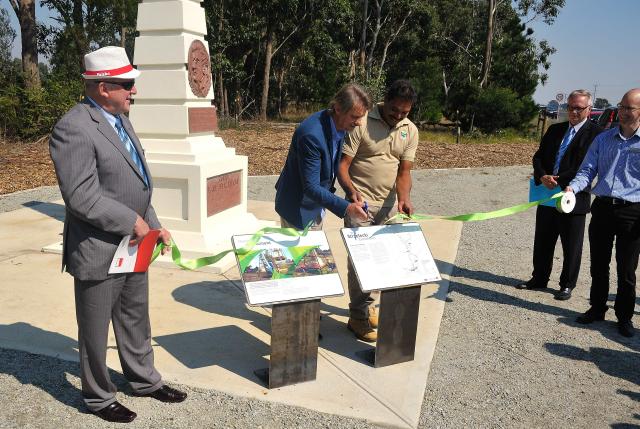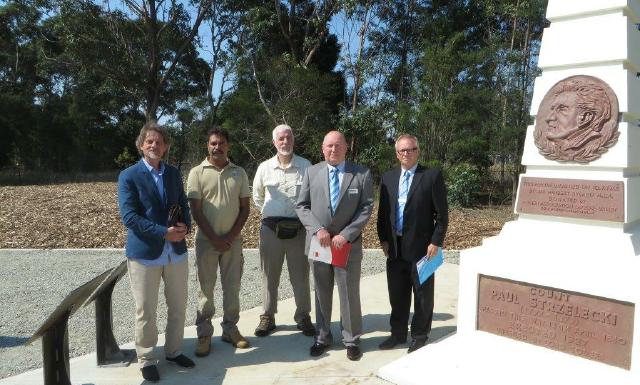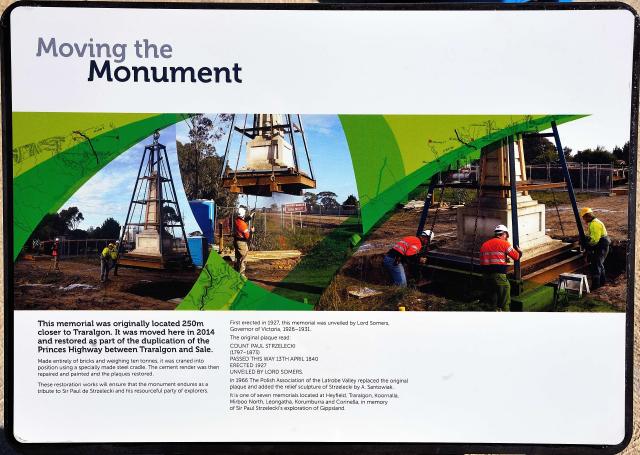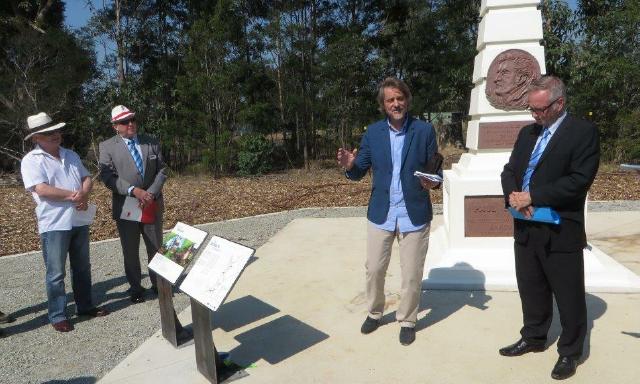| There has been an abundance of good news regarding Sir Paul Edmund de Strzelecki recently. On the 29th of March, a plaque was unveiled in Dublin in honour of the strategy Strzelecki innovated in his humanitarian effort between 1847 and 1849 that saved over 200 thousand children from starvation in Ireland. In an incredible coincidence, on the 31st of March, Vic Roads reopened the Strzelecki monument in Traralgon in honour of Paul Edmund opening Gippsland for settlement in May 1840. Marysia Thiele represented Kosciuszko Heritage in Ireland and I travelled to Traralgon, Victoria.
Mr Charles Broadhurst, Victorian Roads South Eastern Projects Director, began proceedings with a ‘welcome to country’ introduction, noting that Strzelecki and his party, when they were close to starvation just south of Traralgon, had been greatly assisted by their aboriginal guide Charlie Tarra. Mr Broadhurst then introduced Mr Grattan Mullett, Chair of the East Gippsland Aboriginal Community Development Program and member of the GLaWAC Board, who as a local Gunaikurnai man was representing the Aboriginal people at the ceremony.
La Trobe Valley Express about the ceremony
Marian Pawlik, President of the Polish Community Council of Victoria, was called to address the audience:
“Mr Charlie Broadhurst, distinguished guests, ladies and gentlemen, the Polish Community Council of Victoria is extremely grateful to Vic Roads for undertaking and completing the task of restoring and relocating this commemorative obelisk. Sir Paul Edmund Strzelecki has distinguished his name for good in the history of Gippsland and Australia. In 1860, John McDougall Stuart, in honour of the Polish explorer, gave the name of Mount Strzelecki, the highest mountain in the Crawford Range, north of Alice Springs. We can find in the map of Victoria many names in honour of Strzelecki:
• Strzelecki township
• Strzelecki Ranges
• Strzelecki State Forest
• Strzelecki Highway
• And in Traralgon the Strzelecki Motor Inn

On left: Mr Marian Pawlik, president of Polish Community Council in Victoria |
I am not going to mention there used to be a Strzelecki beer as well.In Gippsland we have seven commemorative obelisks:
• Heyfield
• Miriboo North
• Leongatha
• Korumburra
• Koornalla
• Traralgon
• And Corinella
Today we are celebrating the reopening of this obelisk. It is a very important day not only for Polish people but for everyone. Today we are preserving a small part of the history of Australia.
I would like to thank you Mr Broadhurst and your staff for a job well done, and I can only wish that this obelisk and the many others that I mentioned before will never be forgotten and fall into ruins.”

From left:Don Santowiak, Grattan Mullett, Felix Molski, Marian Pawlik & Charles Broadhurst |
I was glad for the opportunity to speak about a side of Strzelecki not as well-known as his exploration and scientific work.[] “I represent a group of volunteers who are trying to get Strzelecki’s name more broadly known, and it’s Kosciuszko Heritage. We of Kosciuszko Heritage seek your help. We seek your help to bring Strzelecki into living memory.
Here’s why. In addition to his explorations and scientific work, Strzelecki was a man of deep compassion. He felt the pain of others, of anyone suffering injustice or distress; and he acted. He acted at an extraordinary level of effectiveness. A “Good Samaritan”.
Nowadays we have “Welcome to Country”. It’s a mark of respect for the traditional custodians of the land. But respect for aboriginal culture, laws and traditions is not extraordinary TODAY. Strzelecki was ahead of his time. In exploring Gippsland and other parts of NSW and VDL he crossed many of around 200 aboriginal tribal borders, trekking 11 thousand km on foot with a 20kg back pack of scientific instruments. No violence, no force, no massacres. Extraordinary! He crossed with permission and respect for tribal law. He understood that each tribe was a nation with its own laws and traditions; not only here but in all his world explorations. In North America he lived with the Huron Indians for about 3 months learning from them and about them. He felt the pain of the injustices native cultures suffered. In Rio he wrote of his deep anguish after eye-witnessing slavery. Later, in England, he became an active Committee member of an anti-slavery organisation set up by the Bishop of Winchester, the son of William Wilberforce..
Just after his book ‘The Physical Description of NSW and VDL” was published he volunteered to help the starving Irish at the time of the Great Hunger. He was assigned the toughest most deeply afflicted Counties – Donegal, Mayo and Sligo. He didn’t collect reports in an office; he went to see for himself the extent of the hunger to form plans on how best to use the resources people around the world had donated to help the Irish.

"Moving the 10 tonne monument. This memorial was originally located 250 m closer to Traralgon. It was moved here in 2004 and restored as part of the duplication of the Princess Highway between Traralgon and Sale." |
Tough countryside, freezing weather, exposure to disease; his deep compassion and physical fitness allowed him to overcome terrible adversity. When blizzards stopped his carriage he continued on, on foot. In late March, 1847 he was struck down by typhus, pulled through and continued undaunted totally throwing himself into relief work. He innovated a simple but powerfully effective strategy that when applied throughout the most distressed districts in Ireland saved over 200 thousand children from starvation. Extraordinary!
From Vic Roads Press Release: An historic marker acknowledging the path of one of Gippsland’s first explorers has been preserved for future generations as part of the duplication of the Princes Highway East.The marker at Traralgon East is one of seven memorials in Gippsland in recognition of
Paul Strzelecki's exploration of Gippsland.
VicRoads South Eastern Projects Director Charlie Broadhurst said the Strzelecki Memorial had to be relocated to make way for the new lanes of the Princes Highway between
Stammers Road and Minniedale Road. VicRoads worked closely with the local Polish community and Traralgon historical society to relocate and restore the memorial.
“The memorial weighs around ten tonnes and is made of brick. A special steel cradle was used to lift it to the new location,” Mr Broadhurst said. “The existing cement render has been repaired and repainted. The plaques fixed to the
memorial in 1966 were also restored. “This memorial was originally erected in 1927 and was restored in 1966 by the Polish Association of the Latrobe Valley."
Strzelecki was tormented by the plight of the children. And it was not just their being barefoot, almost naked and starving in freezing weather; he writes OFTEN with deep feeling of the permanent psychological impact on any who survived. It is perceptible from his words that this gnawed on his psyche; heavily. Writing about if often, suggests that he had painful memories of scars in his own childhood.
Strzelecki’s motivation? It can be inferred from his past experiences:
• He lived under foreign oppression
• He experienced injustice
• He was orphaned at a young age
• He experienced hunger in his youth in Poland and here in Gippsland
• And in his time of need he received help from his Aboriginal guide Charlie Tarra here in Gippsland.
In a remarkable co-incidence, yesterday in Dublin, Strzelecki’s humanitarian deeds were honoured with the unveiling of a plaque. Today here in Traralgon we honour his opening of Gippsland for settlement. Please help spread the word about Strzelecki so that he does become a part of living memory.”
The Strzelecki monument in Traralgon had been previously restored in 1966 and unveiled by Sir Herbert Hyland on 10th July, with the addition of a new plaque and a relief portrait of Strzelecki that was sculpted by Arthur Santowiak and donated by the Polish Association of the Latrobe Valley. A similar restoration had also been completed on the Koornalla Obelisk. Mr Don Santowiak, the sculptor’s son, then spoke:

Second from right: Don Santowiak |
“My name is Don Santowiak, for the people who don’t know me, my late father died two years to the week of this reopening; he is missed today; it would have been an extremely special day for him. So, before I say anything else I would just like to thank Vic Roads and everyone that’s been involved in this and all you people here today for making this an extremely special day for my family and for Dad.
Today I remember back a bit when the sculpture was still being worked on in our garage in a little old busy street in Morwell. Dad was having sleepless nights. He was worried due to the fact that all he had to work with were some old photographs. Little did we know then that this became in 1966 much more than a one off project for him; it became a lifelong obsession about Count Strzelecki. In fact sometimes we were worried about Dad because we thought he had become reincarnated and had become Strzelecki himself.
There has been some mention of the Strzelecki name being used in businesses and streets and so on. Dad was an avid collector of anything that had the Strzelecki name on it; whether it was a business card from a Strzelecki Plumbing in Mirboo North, or the Strzelecki brewery or whatever; it became his great passion. He collected a lot of historical stuff and he was also active in the movement to make sure that the Strzelecki name was spelt correctly across all the places in Australia. Whether it was a street name or whether it was something to do with a sense of history. Dad was very passionate, but it wasn’t Strezlecki, it was Strzelecki. I don’t envy people who don’t quite have the tongue to roll around that, but that’s how it is. So again, I would like to thank Victorian Roads for making this possible today.”
With the speeches at an end, it was time for the cutting of the ribbon; Grattan Mullett and Don Santowiak were honoured and officially reopened the Traralgon Strzelecki Memorial.
At the conclusion of the event, through the generous donations of sponsors dr Ewa Walczak and Jadwiga & George Krajewski Kosciuszko Heritage distributed copies of both the Polish and English versions of the award winning DVD “P. E. De Strzelecki’s Humanitarian Deeds in Ireland.” All those who had attended the reopening ceremony also received from Kosciuszko Heritage written material including:
• an extract form Strzelecki’s book “A Physical Description of New South Wales and Van Diemen’s Land” which shows the deep effect on Strzelecki’s soul when he witnessed ‘man’s inhumanity to man’ on a slaveship ‘which had been forced into the Port of Rio De Janeiro on 22nd January, 1836 by the British war sloop ‘Satellite’;
• the essay about Strzelecki that is published in: ‘Heroes of the Great Irish Famine’ the official Irish Government website established recently in 2014.
Felix Molski
Heroes of the Irish Famine - scroll down to find the submission by Kosciuszko Heritage
Strzelecki a Hero of the Irish Famine - full text of the submission by Kosciuszko Heritage Inc. | 

